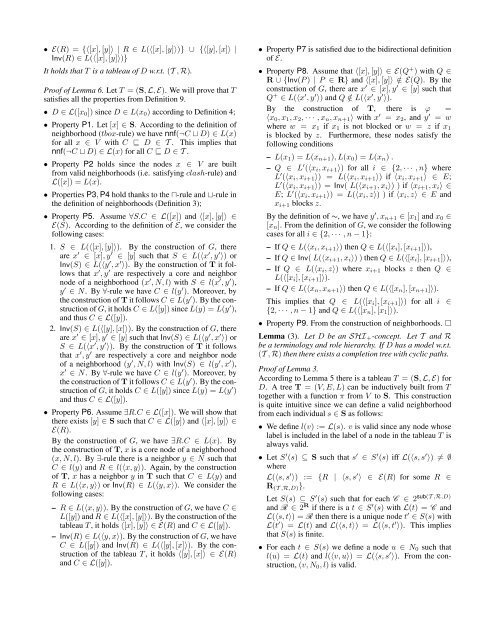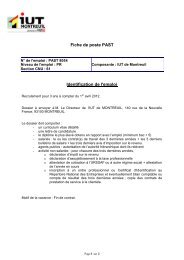Decidability of Description Logics with Transitive Closure of Roles
Decidability of Description Logics with Transitive Closure of Roles
Decidability of Description Logics with Transitive Closure of Roles
You also want an ePaper? Increase the reach of your titles
YUMPU automatically turns print PDFs into web optimized ePapers that Google loves.
• E(R) = {〈[x], [y]〉 | R ∈ L(〈[x], [y]〉)} ∪ {〈[y], [x]〉 |<br />
Inv(R) ∈ L(〈[x], [y]〉)}<br />
It holds that T is a tableau <strong>of</strong> D w.r.t. (T , R).<br />
Pro<strong>of</strong> <strong>of</strong> Lemma 6. Let T = (S, L, E). We will prove that T<br />
satisfies all the properties from Definition 9.<br />
• D ∈ L([x 0 ]) since D ∈ L(x 0 ) according to Definition 4;<br />
• Property P1. Let [x] ∈ S. According to the definition <strong>of</strong><br />
neighborhood (tbox-rule) we have nnf(¬C ⊔ D) ∈ L(x)<br />
for all x ∈ V <strong>with</strong> C ⊑ D ∈ T . This implies that<br />
nnf(¬C ⊔ D) ∈ L(x) for all C ⊑ D ∈ T .<br />
• Property P2 holds since the nodes x ∈ V are built<br />
from valid neighborhoods (i.e. satisfying clash-rule) and<br />
L([x]) = L(x).<br />
• Properties P3, P4 hold thanks to the ⊓-rule and ⊔-rule in<br />
the definition <strong>of</strong> neighborhoods (Definition 3);<br />
• Property P5. Assume ∀S.C ∈ L([x]) and 〈[x], [y]〉 ∈<br />
E(S). According to the definition <strong>of</strong> E, we consider the<br />
following cases:<br />
1. S ∈ L(〈[x], [y]〉). By the construction <strong>of</strong> G, there<br />
are x ′ ∈ [x], y ′ ∈ [y] such that S ∈ L(〈x ′ , y ′ 〉) or<br />
Inv(S) ∈ L(〈y ′ , x ′ 〉). By the construction <strong>of</strong> T it follows<br />
that x ′ , y ′ are respectively a core and neighbor<br />
node <strong>of</strong> a neighborhood (x ′ , N, l) <strong>with</strong> S ∈ l(x ′ , y ′ ),<br />
y ′ ∈ N. By ∀-rule we have C ∈ l(y ′ ). Moreover, by<br />
the construction <strong>of</strong> T it follows C ∈ L(y ′ ). By the construction<br />
<strong>of</strong> G, it holds C ∈ L([y]) since L(y) = L(y ′ ),<br />
and thus C ∈ L([y]).<br />
2. Inv(S) ∈ L(〈[y], [x]〉). By the construction <strong>of</strong> G, there<br />
are x ′ ∈ [x], y ′ ∈ [y] such that Inv(S) ∈ L(〈y ′ , x ′ 〉) or<br />
S ∈ L(〈x ′ , y ′ 〉). By the construction <strong>of</strong> T it follows<br />
that x ′ , y ′ are respectively a core and neighbor node<br />
<strong>of</strong> a neighborhood (y ′ , N, l) <strong>with</strong> Inv(S) ∈ l(y ′ , x ′ ),<br />
x ′ ∈ N. By ∀-rule we have C ∈ l(y ′ ). Moreover, by<br />
the construction <strong>of</strong> T it follows C ∈ L(y ′ ). By the construction<br />
<strong>of</strong> G, it holds C ∈ L([y]) since L(y) = L(y ′ )<br />
and thus C ∈ L([y]).<br />
• Property P6. Assume ∃R.C ∈ L([x]). We will show that<br />
there exists [y] ∈ S such that C ∈ L([y]) and 〈[x], [y]〉 ∈<br />
E(R).<br />
By the construction <strong>of</strong> G, we have ∃R.C ∈ L(x). By<br />
the construction <strong>of</strong> T, x is a core node <strong>of</strong> a neighborhood<br />
(x, N, l). By ∃-rule there is a neighbor y ∈ N such that<br />
C ∈ l(y) and R ∈ l(〈x, y〉). Again, by the construction<br />
<strong>of</strong> T, x has a neighbor y in T such that C ∈ L(y) and<br />
R ∈ L(〈x, y〉) or Inv(R) ∈ L(〈y, x〉). We consider the<br />
following cases:<br />
– R ∈ L(〈x, y〉). By the construction <strong>of</strong> G, we have C ∈<br />
L([y]) and R ∈ L(〈[x], [y]〉). By the construction <strong>of</strong> the<br />
tableau T , it holds 〈[x], [y]〉 ∈ E(R) and C ∈ L([y]).<br />
– Inv(R) ∈ L(〈y, x〉). By the construction <strong>of</strong> G, we have<br />
C ∈ L([y]) and Inv(R) ∈ L(〈[y], [x]〉). By the construction<br />
<strong>of</strong> the tableau T , it holds 〈[y], [x]〉 ∈ E(R)<br />
and C ∈ L([y]).<br />
• Property P7 is satisfied due to the bidirectional definition<br />
<strong>of</strong> E.<br />
• Property P8. Assume that 〈[x], [y]〉 ∈ E(Q + ) <strong>with</strong> Q ∈<br />
R ∪ {Inv(P ) | P ∈ R} and 〈[x], [y]〉 /∈ E(Q). By the<br />
construction <strong>of</strong> G, there are x ′ ∈ [x], y ′ ∈ [y] such that<br />
Q + ∈ L(〈x ′ , y ′ 〉) and Q /∈ L(〈x ′ , y ′ 〉).<br />
By the construction <strong>of</strong> T, there is ϕ =<br />
〈x 0 , x 1 , x 2 , · · · , x n , x n+1 〉 <strong>with</strong> x ′ = x 2 , and y ′ = w<br />
where w = x 1 if x 1 is not blocked or w = z if x 1<br />
is blocked by z. Furthermore, these nodes satisfy the<br />
following conditions<br />
– L(x 1 ) = L(x n+1 ), L(x 0 ) = L(x n ) .<br />
– Q ∈ L ′ (〈x i , x i+1 〉) for all i ∈ {2, · · · , n} where<br />
L ′ (〈x i , x i+1 〉) = L(〈x i , x i+1 〉) if 〈x i , x i+1 〉 ∈ E;<br />
L ′ (〈x i , x i+1 〉) = Inv( L(〈x i+1 , x i 〉) ) if 〈x i+1 , x i 〉 ∈<br />
E; L ′ (〈x i , x i+1 〉) = L(〈x i , z〉) ) if 〈x i , z〉 ∈ E and<br />
x i+1 blocks z.<br />
By the definition <strong>of</strong> ∼, we have y ′ , x n+1 ∈ [x 1 ] and x 0 ∈<br />
[x n ]. From the definition <strong>of</strong> G, we consider the following<br />
cases for all i ∈ {2, · · · , n − 1}:<br />
– If Q ∈ L(〈x i , x i+1 〉) then Q ∈ L(〈[x i ], [x i+1 ]〉),<br />
– If Q ∈ Inv( L(〈x i+1 , x i 〉) ) then Q ∈ L(〈[x i ], [x i+1 ]〉),<br />
– If Q ∈ L(〈x i , z〉) where x i+1 blocks z then Q ∈<br />
L(〈[x i ], [x i+1 ]〉).<br />
– If Q ∈ L(〈x n , x n+1 〉) then Q ∈ L(〈[x n ], [x n+1 ]〉).<br />
This implies that Q ∈ L(〈[x i ], [x i+1 ]〉) for all i ∈<br />
{2, · · · , n − 1} and Q ∈ L(〈[x n ], [x 1 ]〉).<br />
• Property P9. From the construction <strong>of</strong> neighborhoods. □<br />
Lemma (3). Let D be an SHI + -concept. Let T and R<br />
be a terminology and role hierarchy. If D has a model w.r.t.<br />
(T , R) then there exists a completion tree <strong>with</strong> cyclic paths.<br />
Pro<strong>of</strong> <strong>of</strong> Lemma 3.<br />
According to Lemma 5 there is a tableau T = (S, L, E) for<br />
D. A tree T = (V, E, L) can be inductively built from T<br />
together <strong>with</strong> a function π from V to S. This construction<br />
is quite intuitive since we can define a valid neighborhood<br />
from each individual s ∈ S as follows:<br />
• We define l(v) := L(s). v is valid since any node whose<br />
label is included in the label <strong>of</strong> a node in the tableau T is<br />
always valid.<br />
• Let S ′ (s) ⊆ S such that s ′ ∈ S ′ (s) iff L(〈s, s ′ 〉) ≠ ∅<br />
where<br />
L(〈s, s ′ 〉) := {R | 〈s, s ′ 〉 ∈ E(R) for some R ∈<br />
R (T ,R,D) }.<br />
Let S(s) ⊆ S ′ sub(T ,R,D)<br />
(s) such that for each C ∈ 2<br />
and R ∈ 2 R if there is a t ∈ S ′ (s) <strong>with</strong> L(t) = C and<br />
L(〈s, t〉) = R then there is a unique node t ′ ∈ S(s) <strong>with</strong><br />
L(t ′ ) = L(t) and L(〈s, t〉) = L(〈s, t ′ 〉). This implies<br />
that S(s) is finite.<br />
• For each t ∈ S(s) we define a node u ∈ N 0 such that<br />
l(u) = L(t) and l(〈v, u〉) = L(〈s, s ′ 〉). From the construction,<br />
(v, N 0 , l) is valid.
















